Family : Solenostomidae

Text © Giuseppe Mazza

English translation by Mario Beltramini
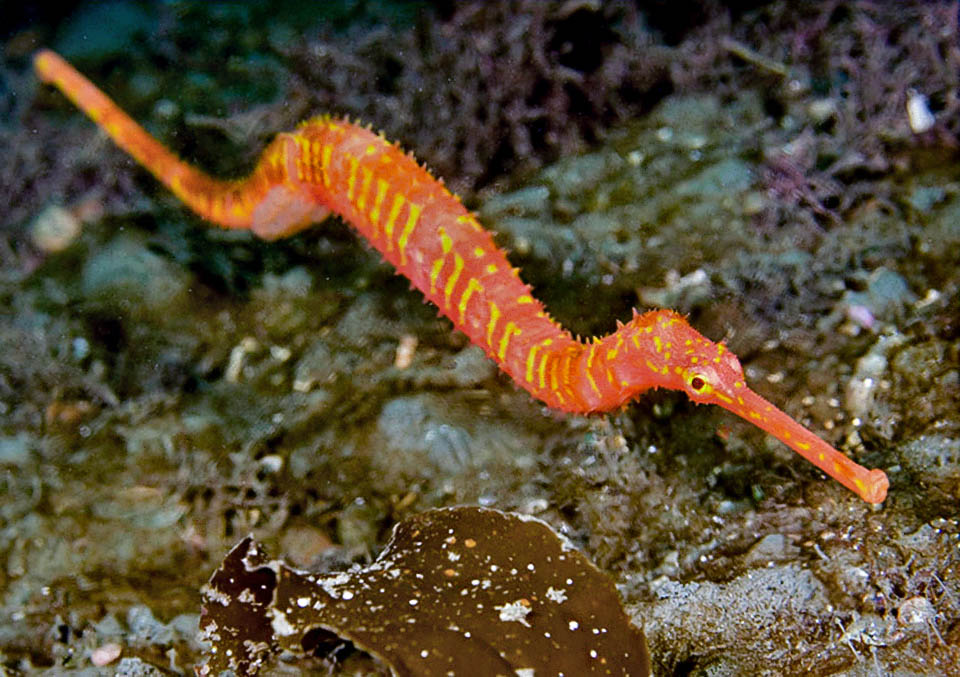
Solegnathus spinosissimus lives mainly in deep waters, between 30 and 230 m, along the Australian coasts from Brisbane to Bass Strait, in Tasmania and New Zealand © Paddy Ryan
Solegnathus spinosissimus (Günther, 1870), commonly known as Spiny seadragon, Spiny pipehorse or Banded pipefish, does indeed possess characteristics evoking these animals, species such as the Common seadragon (Phyllopteryx taeniolatus), the Spotted seahorse (Hippocampus kuda) or the Ringed pipefish (Dunckerocampus dactyliophorus).
In fact, it is not by chance that all belong to the family of the Syngnathidae, inserted in the order of the Syngnathiformes with other 4 families: the Aulostomidae known as trumpetfishes, the Centriscidae called razorfishes, the Solenostomidae called ghost pipefishes and the Fistulariidae that form the cornetfishes.
Common characteristics to all these groups are the jaws joined together to form a tube, often imposing, but the adults of the genus Bulbonaricus that lose it, like Bulbonaricus brauni during their passage from the larval stage to the adult one.
The generic name Solegnathus originates, with reference to this tool, from the old Greek “σωλήν” (sōlḗn), channel, tube, and “γνάθος” (gnathos), jaw, because of the tubiform jaw, whilst the specific term spinosissimus, very spiny, in Latin, reminds us of the countless spines present on its body.
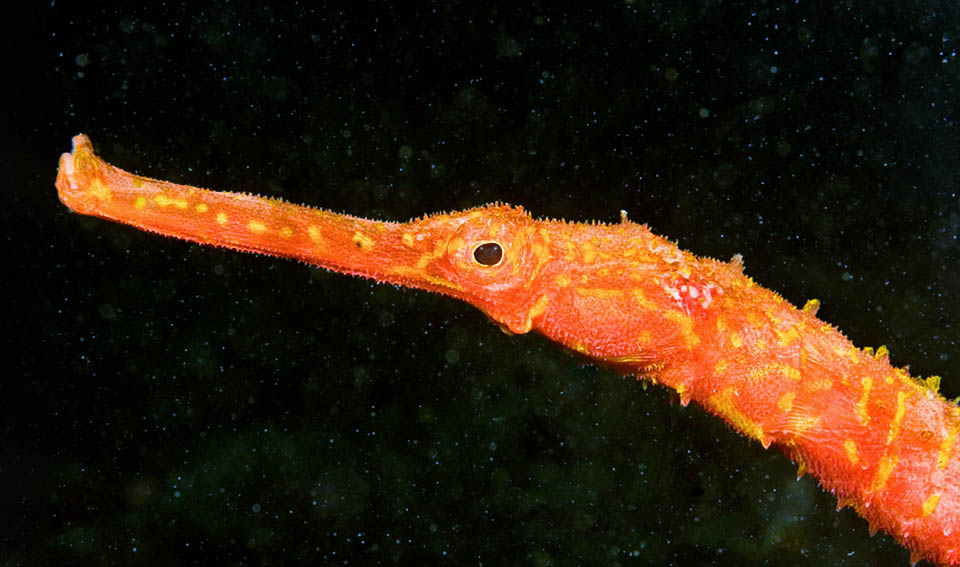
Similar to seadragons, hippocampuses and pipefishes, has the typical long snout of the Syngnathidae done for sucking and swallowing entire small prey © Paddy Ryan
Zoogeography
Solegnathus spinosissimus lives in the south-western Pacific and particularly from the waters off Sunshine Coast in South Queensland, up to the Bass Strait that separates the state of Victoria from Tasmania. Then from Cape Otway reaches this last and finally New Zealand.
Ecology-Habitat
The Spiny seadragon needs relatively low temperatures, included between 9 and 15,5 °C, and usually moves on the detrital sandy or silty bottoms between 30 and 230 metres of depth, often clinging with its prehensile tail to seaweeds, corals and sponges, like the seahorses, in order not to be carried away by the currents, or even worse, as sometimes happens, ending up miserably on the beaches dragged there by a storm.
In the northern part of its range, it lives mainly in deep waters, whilst south it often goes swimming in lower waters and in the brackish ones of the Derwent estuary, near Kingston in Tasmania, it can be found even in 2-3 m of water.
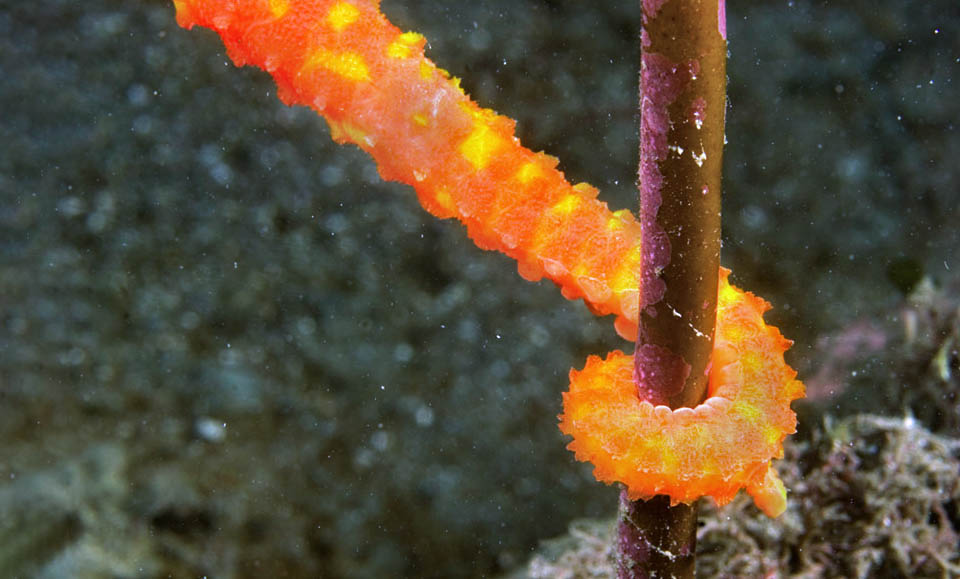
Like seahorses it fixes to the bottoms with its prehensile tail to resist the currents and catch on its way the zooplankton passing close to it © Paddy Ryan
Morphophysiology
Solegnathus spinosissimus can be 49 cm long. It has no scales but is protected by spiny bony plates supported by rings, 24-27 for the trunk, and 51-59 for the tail, forming defensive crests more evident in the juveniles. There are 3 of them on the sides of the body and 2 on the caudal ones. The mouth is oblique, at the apex of the long snout, has no teeth and its tiny preys are swallowed whole.
Characteristics are the covering of the operculum and the showy truncated spine just under the pectoral fin that distinguishes it, together with Solegnathus robustus, from the other congeners, whilst differs from the latter for the slimmer snout, the back less convex and the flat ventral side in the first caudal trait.
The modest caudal fin, placed in a very backward position over the microscopic anal fin, is practically the only motor of the fish, who swims as it can, disorderly, with the undulations of its 35-42 unarmed rays. The small pectoral fin, placed close to the head with 23-26 soft rays, serves mainly for maintaining the trim and for changing direction.
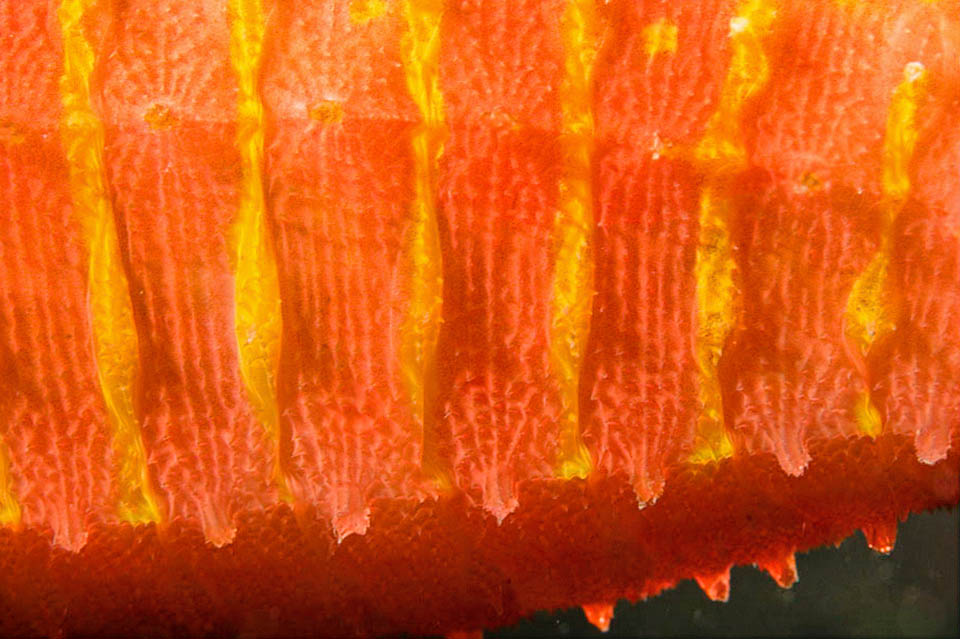
It has no scales but is protected by spiny bony plates forming long defensive crests. The livery is usually orange red with yellow vertical bands © Paddy Ryan
The background colour of the livery is orange red or pinkish, at times with seven zones having symmetrical black spots on the back. The sides are crossed by several narrow vertical yellow bands that transform in spots on the tail. Dottings and small yellow traits are present also on the back, the head and the snout. A characteristic red spot stands near the anus.
Ethology-Reproductive Biology
Anchored with its prehensile tail, Solegnathus spinosissimus nourishes of zooplankton, especially of small crustaceans and larvae of fishes it catches while passing by.
Starting from the length of 20 cm, but usually around the 30, the males can reproduce.
Under the first part of the tail, their tissue gets spongy, like for the pipefishes and the seadragons, ready to host and incubate the 60-200 eggs glued by the female.
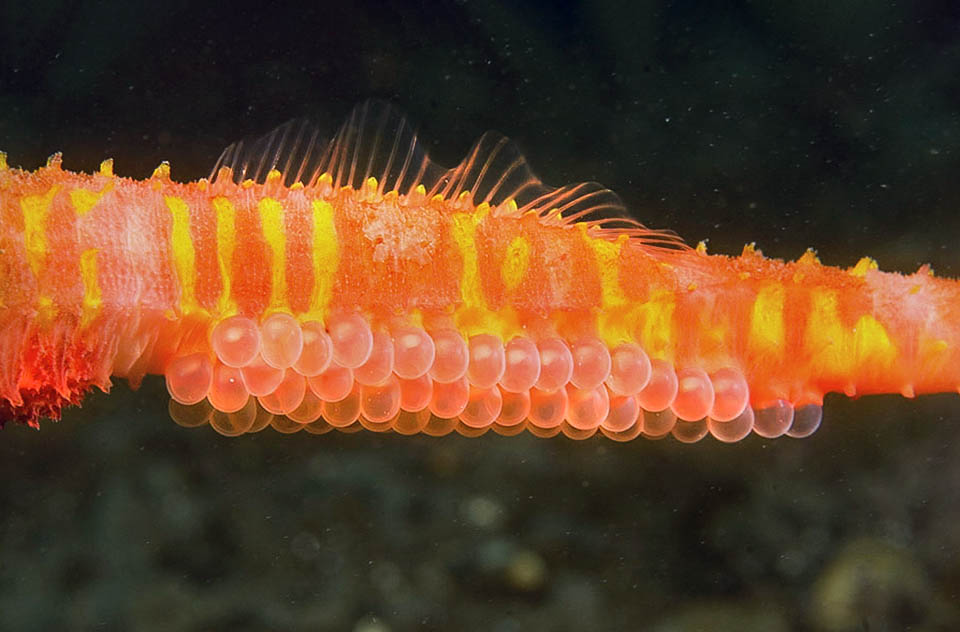
Close-up of the eggs in incubation under the tail of the male. The modest dorsal fin is not adequate for a fish measuring almost half a metre © Paddy Ryan
It seems however that the newborns are not pelagic and lead immediately a benthic life.
Like the seahorses, the Spiny seadragon is still now required by the Chinese medicine that utilized it, reduced in powder, for medicinal or aphrodisiac preparations. unfortunately gets even accidentally into the trawl nets and is nowadays, in 2022, the resilience is good with a possible doubling of the populations in 1,4-4,4 years, the index of vulnerability to the fishing marks already marks 39 on a scale of 100.
In the Red List Solegnathus spinosissimus is labelled as “Data Deficient”, that means that there are not enough elements for evaluating if it is endangered.
Synonyms
Solenognathus spinosissimus Günther, 1870; Solenognathus fasciatus Günther, 1880; Solegnathus fasciatus Günther, 1880.
→ For general information about FISH please click here.
→ For general information about BONY FISH please click here
→ For general information about CARTILAGINOUS FISH please click here.
→ To appreciate the BIODIVERSITY of BONY FISH please click here.
→ To appreciate the BIODIVERSITY of CARTILAGINOUS FISH please click here.
